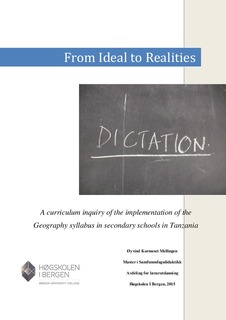| dc.contributor.author | Mellingen, Øyvind Kormeset | |
| dc.date.accessioned | 2018-02-01T14:55:26Z | |
| dc.date.available | 2018-02-01T14:55:26Z | |
| dc.date.issued | 2015-05 | |
| dc.identifier.uri | http://hdl.handle.net/11250/2481601 | |
| dc.description | Masteroppgave i samfunnsfagsdidaktikk | |
| dc.description.abstract | This study investigates how the Tanzanian geography syllabus is implemented and used in a secondary school. In order to understand how much of the syllabus is recognizable in the actual teacher’s practice, John I. Goodlad’s substantive domains are applied on the data material. The substantive domains are different levels of curricula emerging through the implementation process and this thesis emphasize on three of them. It investigates the differences between the formal curriculum (the official written syllabus), and the perceived curricula (the teachers’ interpretations of the syllabus), and the operational curricula (the teachers’ actual practice). The study is based on material originating from a fieldwork in Tanzania in the fall of 2014, including participant observations, interviews and content analysis of the syllabus. The findings reveal that the ideal of the national syllabus is hard to recognize in the realities of Tanzanian classrooms. During the implementation process large gaps occur between the substantive domains. National exams are one of the key gap generators. The operational curricula involves around passing these exams, which emphasize different content and cognitive processes than the national syllabus. Lack of resources, the teacher training and an overambitious syllabus is other contributors to these gaps, resulting in a curriculum that goes from an ideal to very different realities. | en_GB |
| dc.description.abstract | Denne studien undersøker korleis den tanzanianske læreplanen i geografi blir implementert og brukt i ein secondary school. Ved å nytte John I. Goodlad’s læreplannivå, kan ein analysere kor mykje av læreplanen som blir implementert i den faktiske undervisninga. Denne oppgåva vil undersøke skilnadane mellom den formelle læreplanen (den skriftlege og offisielle læreplanen) og den oppfatta læreplanen (lærarane si tolking) og den operasjonelle læreplanen (lærarane si faktiske undervisning). Studien er basert på materiale frå eit feltarbeid i Tanzania hausten 2014 og omfattar deltakande observasjon, intervju og innhaldsanalyse av læreplanen. Mine funn avslører at idealet i den nasjonale formelle læreplanen er vanskeleg å kjenne at i realitetane i tanzanianske klasserom. Gjennom implementeringsprosessen oppstår det store gap mellom dei ulike læreplannivåa. Nasjonale eksamenar er ein av dei største årsakene til den store avstanden. Den operasjonelle læreplanen fokuserer på å få elevane til å bestå eksamen. Eksamen vektlegg eit anna innhald og kognitive prosessar enn den formelle læreplanen. Mangel på ressursar, lærarutdanning og ein overambisiøs læreplan er andre faktorar til disse gapa, noko som fører til ein læreplan som går frå eit ideal til veldig forskjelleie realitetar. | en_GB |
| dc.language.iso | eng | en_GB |
| dc.publisher | Høgskolen i Bergen | en_GB |
| dc.subject.other | Tanzania | en_GB |
| dc.subject.other | læreplan | en_GB |
| dc.subject.other | geografi | en_GB |
| dc.subject.other | læraren sin praksis | en_GB |
| dc.title | From ideal to realities | en_GB |
| dc.type | Master thesis | en_GB |
